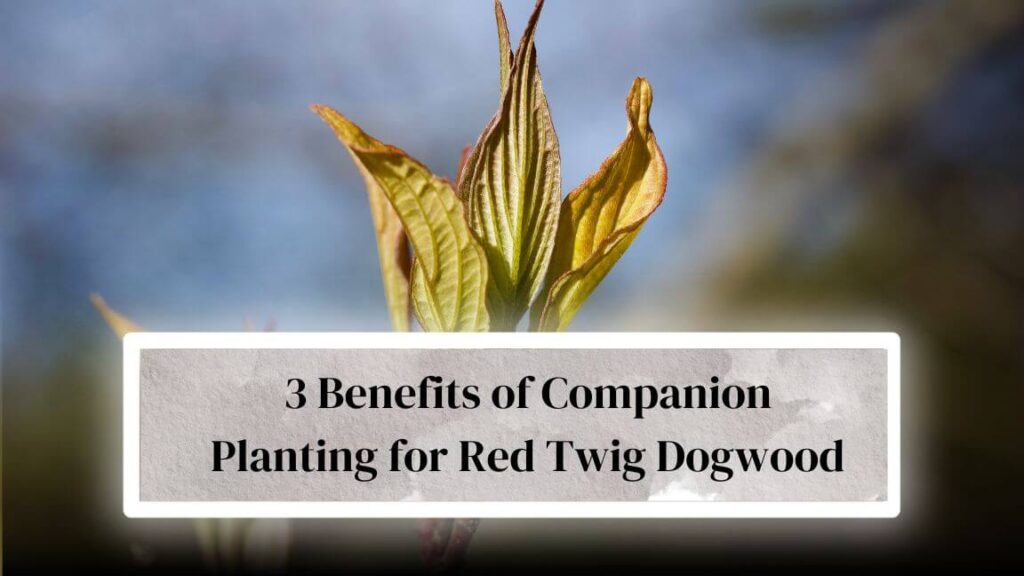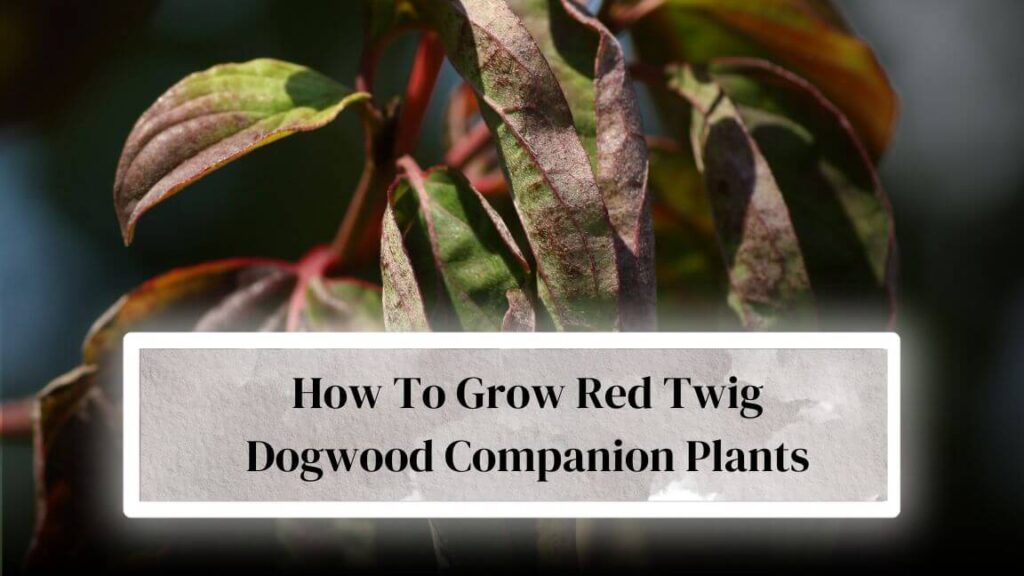
If you want to learn about Red twig dogwood companion plants, this article is for you. Since companion planting improves the overall diversity of your garden and crop yields, deters pests, and promotes soil health, every individual should try companion planting once in their lifetime on their landscape.
Here, in this article, we will discuss some companion plants that can grow alongside red twig Dogwood because they have natural affinities with each other & can help each other grow better. But before all these, let’s talk about the benefits of companion planting for red twig dogwood.
3 Benefits of Companion Planting for Red Twig Dogwood

- Improving soil health: Did you know that Companion plants can help you improve the soil by adding organic matter, fixing nitrogen, & increasing microbial activity?
- Providing shade: Since the Red Twig Dogwood tree doesn’t like the full sun, you can consider providing shade by planting some companion plants.
- Attracting beneficial insects: You should always practice companion plants that attract beneficial insects like bees & butterflies. This will help you pollinate your Red Twig Dogwood and control pests in your garden.
- Adding aesthetic appeal: if you’re like me and love to add visual interest & contrast to your garden, practice companion planting with Red Twig Dogwood to create a more attractive garden.
- Reducing competition: Believe it or not, Companion plants also help reduce competition for resources like nutrients & water, allowing your Red Twig Dogwood to thrive for longevity.
How Companion Planting Helps Improve Soil Health
As I told you earlier, Companion planting can help you improve soil health in several ways. You should grow legumes like clover or beans with Red Twig Dogwood, especially if you want to help fix nitrogen in the soil, which is essential for all plant growth.
Similarly, if you want to cover crops, you can grow winter rye or buckwheat, preventing erosion while improving soil structure. In addition, you can increase microbial activity in the soil through companion planting, which breaks down organic matter & releases nutrients for plant uptake.
However, if you want to add pop color and interest to your garden, add some flowering companion plants for red twig dogwood.
Related Article: 7 Landscaping Ideas With Red Twig Dogwood
5 Flowering Companion Plants For Red Twig Dogwood
Below, I list five flowering companion plants for your Red Twig Dogwood that you can grow to add interest and diversity to your yard. These five recommended plants make great companions alongside shallow-rooted dogwoods.
| Plant Name | Seasonal Interest | Blooming Time |
| Coneflower (Echinacea purpurea) | Summer | July to September |
| Black-eyed Susan (Rudbeckia hirta) | Summer | June to October |
| Russian Sage (Perovskia atriplicifolia) | Summer to fall | August to September |
| Butterfly Weed (Asclepias tuberosa) | Summer | July to August |
| Blue Star (Amsonia hubrichtii) | Spring to summer | May to June |
5 Evergreen Companion Plants For Red Twig Dogwood
Since dogwood trees usually bloom in spring, you will want to add some companion plants that give year-round interest to your Red Twig Dogwood. If yes, consider planting evergreen companions like these fives that would make great companions.
| Plant Name | Year-round Interest | Foliage |
| Inkberry Holly (Ilex glabra) | Yes | Dark green |
| Wintergreen (Gaultheria procumbens) | Yes | Glossy green |
| Boxwood (Buxus sempervirens) | Yes | Dark green |
| Dwarf Alberta Spruce (Picea glauca var. albertiana ‘Conica’) | Yes | Green |
| Hinoki Cypress (Chamaecyparis obtusa) | Yes | Green |
5 Ground Cover Companion Plants For Dogwood
Now, if you’re looking to prevent soil erosion and suppress weeds, you need to add ground cover. This is especially important for Red Twig Dogwood since it prefers moist, well-drained soil. Thus, below are five recommended ground cover plants that would make great companions to red twig dogwood trees & bushes:
| Plant Name | Seasonal Interest | Characteristics |
| Creeping Phlox (Phlox subulata) | Spring | Low-growing, spreads quickly |
| Hosta (Hosta spp.) | Summer | Shade-loving, attractive foliage |
| Japanese Pachysandra (Pachysandra terminalis) | Spring | Evergreen, shade-loving |
| Lamium (Lamium maculatum) | Spring to fall | Low-maintenance, shade-loving |
| Sweet Woodruff (Galium odoratum) | Spring | Fragrant, spreads quickly |
5 Fruit-bearing Companion Plants For Dogwood
Since you can’t eat fruits from red twig dogwood as those are poisonous, you can try to add other Fruit-bearing plants that will attract birds & other wildlife to your garden, which are very beneficial for pollination & pest control. Below, I’ve listed five of my favorite fruit-bearing plants that thrive alongside dogwoods.
| Plant Name | Seasonal Interest | Characteristics |
| Elderberry (Sambucus canadensis) | Summer | Edible fruit, attracts birds |
| Blueberry (Vaccinium spp.) | Spring | Edible fruit, acid-loving |
| Serviceberry (Amelanchier spp.) | Spring | Edible fruit, attracts birds |
| Raspberry (Rubus spp.) | Summer | Edible fruit, spreads quickly |
| Highbush Cranberry (Viburnum trilobum) | Fall | Edible fruit, attracts birds |
5 Fragrant Companion Plants for Dogwood
Since I spend most of my daytime in my outdoor space with my pets & kids during winter, I like having Fragrant plants, which add a delightful scent to the garden while attracting pollinators like bees & butterflies.
Many don’t like the smell of dogwoods; if you’re one of them, below are five recommended fragrant plants you should try to grow during companion planting practices.
| Plant Name | Seasonal Interest | Characteristics |
| Lavender (Lavandula spp.) | Summer | Attractive foliage, drought-tolerant |
| Sweet Alyssum (Lobularia maritima) | Summer to fall | Low-growing, spreads quickly |
| Rose (Rosa spp.) | Summer to fall | Beautiful flowers, attracts pollinators |
| Dianthus (Dianthus spp.) | Summer to fall | Fragrant, attractive foliage |
| Lilac (Syringa spp.) | Spring | Beautiful flowers, attracts pollinators |
How To Grow Red Twig Dogwood Companion Plants

Step 1: Choose the Right Companion Plants
Firstly, you must choose the right type of companion plant that can thrive in the same growing condition as your red twig Dogwood.
Above I have mentioned all the plants compatible with growing alongside red twig Dogwood and provide many benefits according to their features. A few other plants you can successfully grow alongside dogwood trees are.
- Hydrangeas: Hydrangeas are very popular flowering shrubs that make an excellent companions for red twig dogwood because they also need similar soil conditions & moisture levels to thrive.
- Lilacs: Another flowering plant you can successfully grow alongside Dogwood is lilacs. Since Lilacs have shallow root systems, it’s an excellent choice for planting near red twig dogwood, which has a deep root system.
- Daylilies: Since red twig dogwood can compete with its companion plant for resources like nutrients, water, and oxygen, you can opt for Daylilies, which are hardy perennials. They can easily withstand the competition for nutrients & water that occurs when planted alongside red twig dogwood.
Step 2: Planting Companion Plants
If you’re planting companion plants with your red twig dogwood, there are a few things that you must keep in mind:
- Spacing: you must provide proper space for each plant, especially when practicing companion planting. Ensure that your companion plants have enough space to grow & thrive without being overcrowded by your red twig Dogwood.
- Soil Preparation: Before planting, you must prepare the soil by adding organic matter like compost or aged manure to improve soil fertility. Also, check the pH level and treat the soil accordingly.
- Watering: We need to water the plants thoroughly after planting. You must provide adequate moisture throughout the growing season to all your plants.
Related: Dogwood Tree Planting Instructions
Step 3: Tips for Caring for Companion Plants
- Adjust Spacing: If you notice Overcrowding, you need to adjust the spacing between your plants by moving or relocating them. You must provide each plant with more space, reducing resource competition and improving growth.
- Mulch: I find mulching the best way to suppress weed growth and retain moisture during dry spells or the hottest part of the day. Mulching will also help you reduce competition between your companion plants for resources by regulating the soil temperature and protecting their root from extreme temperatures.
Remove Infested Plants: if you don’t take care of the proper maintenance around your trees & plants while maintaining proper pest control, your trees are at risk of infestations. Therefore, consider proper learning on How To Take Care Of A Dogwood Tree.
In case, If you notice a pest infestation, you first need to remove the affected plants immediately to prevent the infestation from spreading to other plants in the garden.
After that, you need to use organic pest control methods like neem oil or insecticidal soap. Only go with the chemical pesticides as they can damage your surrounding plants and even the tree at which you are applying it if done correctly.
Also Read: 11 Best Ivory Halo Dogwood Companion Plants
3 Strategies for Maximising the Benefits of Companion Plants
- Crop Rotation: Rotating your crops every season helps prevent soil-borne diseases and prevents pests from building up in your soil.
- Companion Planting Guides: If you need clarification or help to select the best plants to grow alongside your red twig Dogwood, consider using companion planting guides for help.
- Observation: You should observe your plants regularly and check for any problems early to take appropriate action promptly and prevent them from spreading.
3 Mistakes to Avoid When Choosing Companion Plants
Choosing Invasive Species
One of the most common companion planting mistakes that beginners often make is choosing invasive species. You should never use Invasive species as those quickly take over and outcompete other plants in your garden.
Plus, they can be very challenging to control once established. It would help if you researched the plants you’re considering to ensure they’re not invasive in your area. Some invasive plants you must avoid include Japanese knotweed, purple loosestrife, & kudzu.
Ignoring Soil Requirements
I hope you know that different plants have different soil requirements. Therefore, don’t do it if you’re planting a companion plant with vastly different soil needs than the red twig dogwood.
This can lead seriously to poor growth & competition for resources. Before you begin to plant any specimen, research the soil requirements of the red twig dogwood and the companion plants you’re considering.
Overcrowding
Another common mistake that people make when they practice companion planting is Overcrowding.
If you don’t provide each plant enough space to grow and access the resources it needs to thrive, Overcrowding will occur, leading to resource competition.
If Overcrowding persists, it will lead to poor growth and increased competition for water & nutrients. You need to do your research to plant any specimen.
Conclusion
After reading this article, you will have no issue finding the right type of companion plant for Dogwood. I like having flowering, fragrant, and fruit-bearing companion plants alongside my dogwood trees that attract white-life pollinators and beneficial insects.
If you want, you can also go with any of these types of companion plants to grow with your red twig Dogwood. If you find this article helpful, then consider sharing it.
Your share will help many people learn about the best companion plants to grow alongside red twig dogwood. Check our other helpful guides on this website regarding dogwood tree care & management. Say you in the next post till then take care and goodbye.
